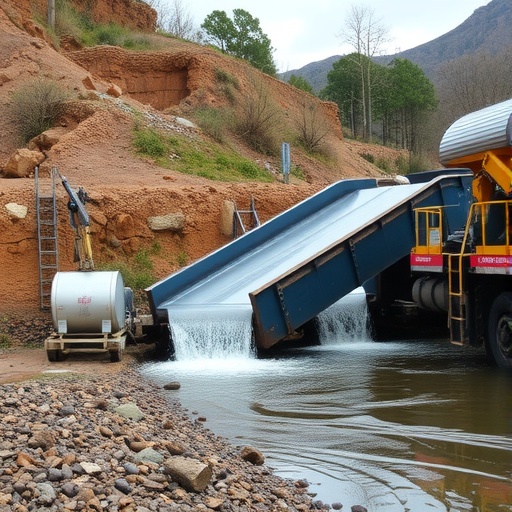In an era where high-speed rail infrastructure is pivotal for modern transportation, the durability and stability of railway subgrades have become critical engineering challenges. Recent research conducted by Pei, Deng, Zhang, and their colleagues shines a spotlight on the often-overlooked complexities involving mudstone subgrades in high-speed railways. Their model test study, published in Environmental Earth Sciences, elucidates the profound influence of unloading-water interactions on the wet-swelling deformation of these foundational materials, emphasizing the delicate balance between geotechnical sustainability and advancing transportation technologies.
Mudstone, a fine-grained sedimentary rock, has garnered increasing attention in railway engineering due to its complex mechanical behavior under variable environmental conditions. The swelling potential, particularly under wet conditions, presents a persistent threat to subgrade integrity, which in turn jeopardizes railway safety and efficiency. The researchers ventured into this niche problem, probing how the coupling effect of unloading – a process mimicking stress relief during excavation or usage – and the ingress of water can dramatically redefine the deformation characteristics of mudstone subgrades.
Central to the study was a sophisticated model test system that simulated the realistic conditions experienced by mudstone layers beneath railway tracks. This involved replicating stress unloading representative of railway construction or intermittent load changes and controlling moisture content to observe deformation patterns accurately. By integrating mechanical unloading with varying water saturation levels, the team discerned nuanced deformation behaviors that traditional static or dry tests fail to capture.
Their findings revealed that the interaction between unloading and water presence intensifies the wet-swelling deformation, exceeding previous projections made from analyses that treated these factors independently. The swelling deformations were not just larger in magnitude but exhibited nonlinear responses, underscoring a complex synergy. This demonstrates that moisture alone or unloading individually underrepresents the hazard potential; instead, their concurrent effects amplify the risk substantially.
More specifically, when mudstone subgrades undergo stress unloading, microcracks and fissures develop, enhancing permeability and providing pathways for water infiltration. This dynamic transformation alters the pore-water pressures and weakens the internal structure, facilitating a more pronounced swelling response. Of particular concern is the implication of these dynamics on high-speed railway operations, where even millimeter-scale deformations can translate into dangerous track irregularities, affecting ride comfort and safety.
The methodology utilized by Pei and colleagues incorporated meticulous measurement techniques, including precise deformation monitoring and moisture content tracking, to unravel the time-dependent behaviors of mudstone samples under simulated environmental conditions. Such temporal analyses shed light on progressive deformation trends, critical for developing predictive maintenance models and early-warning systems in railway subgrade management.
Moreover, the authors highlight the variability of swelling characteristics across mudstone types and regions, suggesting that localized geological surveys are indispensable in accurately assessing unloading-water coupled effects. This points to the need for bespoke infrastructural designs and adaptive engineering solutions tailored to site-specific mudstone properties to mitigate risk effectively.
The revelations from this study are poised to impact not only the design and construction phases but also the operational maintenance strategies for high-speed railway networks. Incorporating these nuanced understandings into geotechnical assessment protocols can optimize the selection criteria for subgrade materials and enhance the efficacy of drainage systems meant to control water infiltration.
Furthermore, the advanced model testing approach sets a precedent for future geotechnical research, advocating for an integrated perspective that embraces the multifaceted environmental and mechanical factors influencing subgrade behavior. This could spark a paradigm shift in how infrastructure resilience is studied, with implications extending beyond railways to other civil engineering domains where swelling soils and rocks prevail.
Notably, the environmental implications of such deformation phenomena also deserve attention. Swelling and the resultant structural shifts in subgrades could disturb surrounding ecosystems, particularly in sensitive areas, thereby linking geotechnical engineering concerns with broader environmental stewardship obligations. Future research trajectories may well explore these interdependencies to formulate sustainable railway construction and maintenance practices.
The study represents the cutting-edge intersection of geology, civil engineering, and environmental sciences, embodying a holistic approach to complex infrastructural problems. By elucidating the hitherto underexplored unloading-water interaction on mudstone swelling, Pei et al. pave the way for safer, more reliable high-speed rail systems in regions afflicted by troublesome subgrade conditions.
In the context of growing global demands for rapid transit and the continual expansion of railway networks, understanding and mitigating the challenges posed by geotechnical complexities is paramount. This research enriches the scientific foundation upon which future engineering safeguards can be constructed, potentially influencing policy guidelines and construction standards worldwide.
Additionally, this work holds relevance for nations embarking on new railway projects across terrains characterized by problematic mudstone layers. The insights offered could dramatically improve the management of construction risks, budgeting for maintenance, and ensuring long-term operational robustness.
To encapsulate, the interplay between mechanical unloading and water presence emerges as a critical driver of wet-swelling deformation in high-speed railway mudstone subgrades. Grappling with this interplay through rigorous model testing and scientific inquiry marks a significant stride toward engineering solutions that ensure safety, durability, and economic efficiency in railway infrastructures.
As the research community digests these findings, interdisciplinary collaboration will be essential to translate laboratory insights into field applications, integrating geological surveys, material science innovations, and advanced monitoring technologies. Such concerted efforts hold the promise of rehabilitating vulnerable subgrade sections before catastrophic failures occur and enhancing the predictability and resilience of high-speed rail networks globally.
Ultimately, the investigative model proposed by Pei and colleagues exemplifies how targeted experimental studies can unearth critical phenomena lurking beneath our transportation highways. The intricate dance between rock mechanics and hydrological influences is not just an academic curiosity but a tangible challenge demanding urgent attention from engineers, planners, and policymakers alike.
Subject of Research: Influence of unloading-water interaction on wet-swelling deformation in high-speed railway mudstone subgrades.
Article Title: Model test study on the influence of unloading-water interaction on wet-swelling deformation of high-speed railway mudstone subgrade.
Article References:
Pei, L., Deng, H., Zhang, T. et al. Model test study on the influence of unloading-water interaction on wet-swelling deformation of high-speed railway mudstone subgrade. Environ Earth Sci 84, 624 (2025). https://doi.org/10.1007/s12665-025-12644-z
Image Credits: AI Generated




